Ramjet Engine, Design and Combustion Optimization (SR-71 Blackbird), Industrial Application
Original price was: $780.00.$390.00Current price is: $390.00. Student Discount
- In this project, an industrial Ramjet Engine has been numerically simulated by ANSYS Fluent software.
- Studying Combustion, Mach Number, Pressure, Density (Compressible Flow), and Thermal analysis.
- Optimizing the Thrust number.
- Ramjet Design Improvement.
- RSM analysis applying DOE.
To Order Your Project or benefit from a CFD consultation, contact our experts via email ([email protected]), online support tab, or WhatsApp at +44 7443 197273.
There are some Free Products to check our service quality.
If you want the training video in another language instead of English, ask it via [email protected] after you buy the product.
Description
Introduction
An air-breathing jet engine, known as a ramjet, compresses incoming air instead of utilizing a rotary compressor by moving the engine forward. A ramjet cannot operate at zero airspeeds; hence it cannot be utilized to power an aircraft throughout all phases of flight. A ramjet-equipped aircraft needs additional propulsion to accelerate it to a speed where the ramjet can provide thrust.
In the combustor of a ramjet, combustion that generates thrust happens at a subsonic speed. The aircraft inlet must slow the air entering the engine for a vehicle operating at supersonic speeds. The propulsion system suffers performance losses due to shock waves in the inlet. Ramjet propulsion is relatively inefficient over Mach 5.
In this situation, fuel is crucial. When considering other beneficial factors, such as the fact that the air’s overall Temperature is high at high Mach numbers, hydrogen is especially advantageous due to its well-known relatively short inflammatory delay.
Project Description
In this simulation, an SR-71 Black Bird moving with a Mach number of 3.3 is considered. The point is to model the ramjet engine to capture what happens there and investigate the parameters.
In the next step, 3 crucial parameters are selected, and the solution is optimized using the DOE method in ANSYS Workbench software.
-
Ramjet CFD Simulation
As mentioned above, the first step is to simulate the engine of the SR-71 Black Bird, which is a ramjet engine without any moving object inside. The jet is moving with a Mach number of 3.3. There is an injection slot inside the chamber at a distance of 70 cm from the chamber inlet. The fuel, which is hydrogen, is injected into the engine with a mass flow rate ratio of 1 to 50 relevant to the air. Notably, the injection angle is 0 degrees, meaning the fuel is injected perpendicular to the airflow.
The model of the ramjet engine and the solution results are visible in the following figures, considering different significant parameters for us.
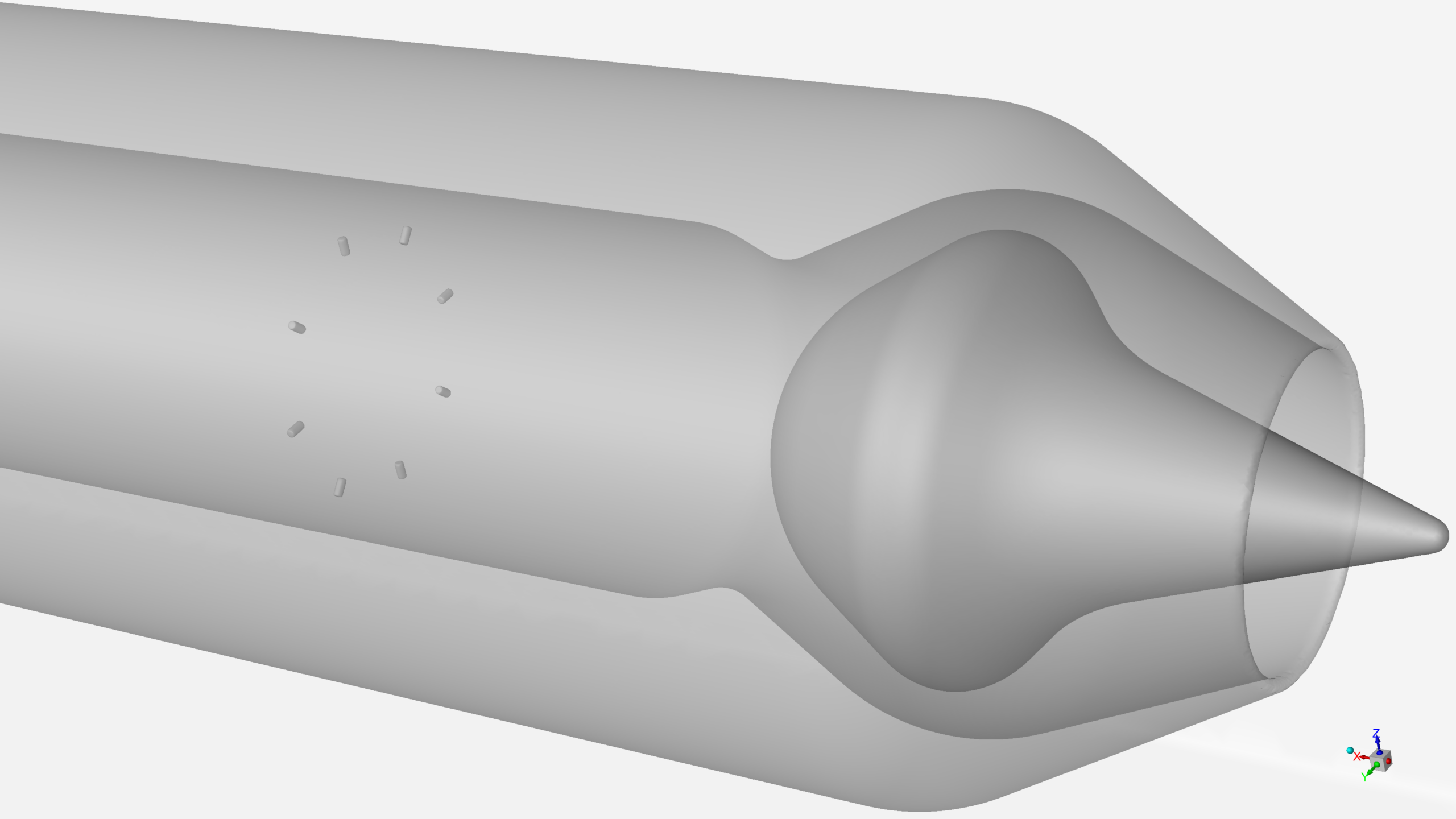

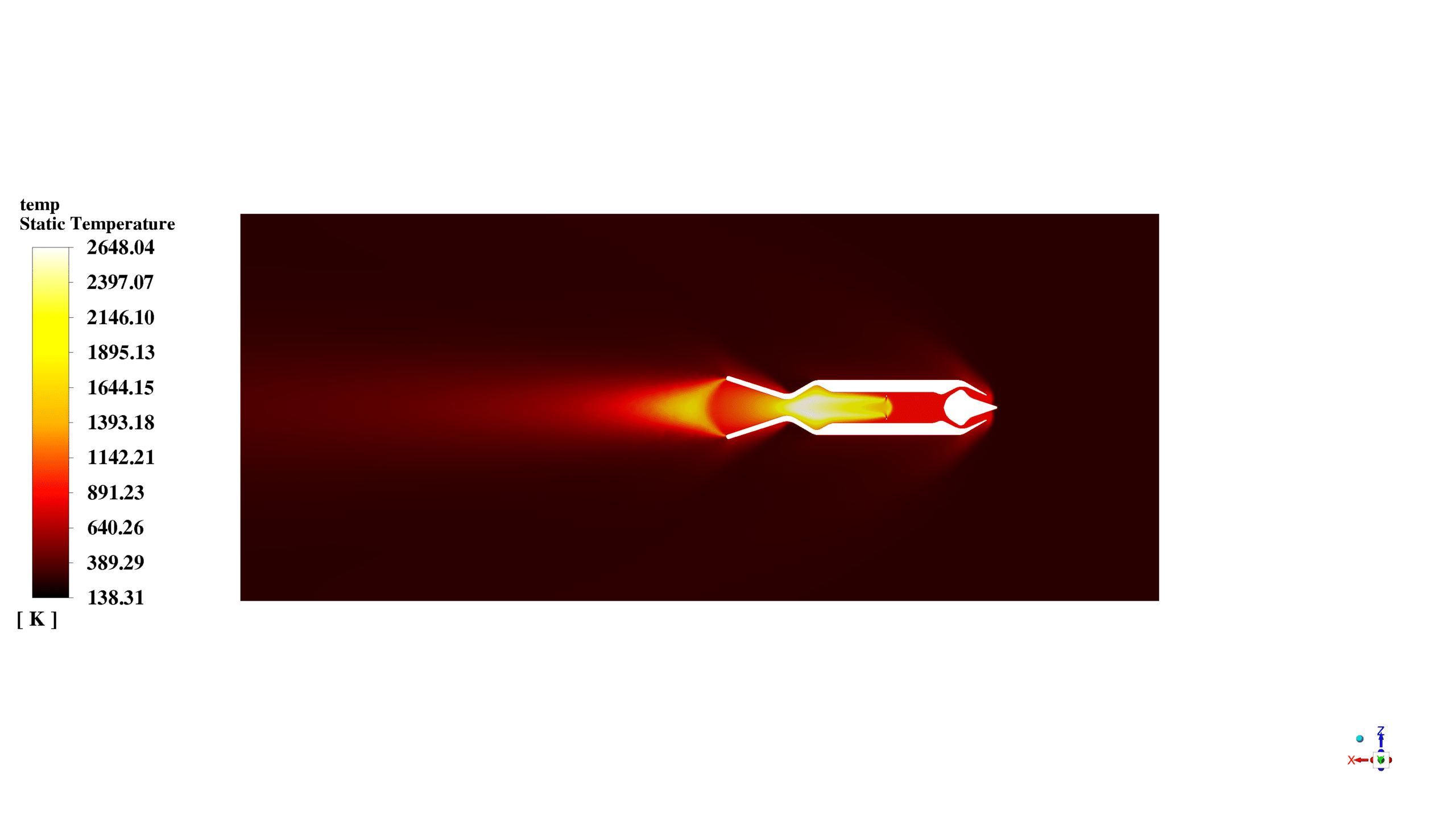
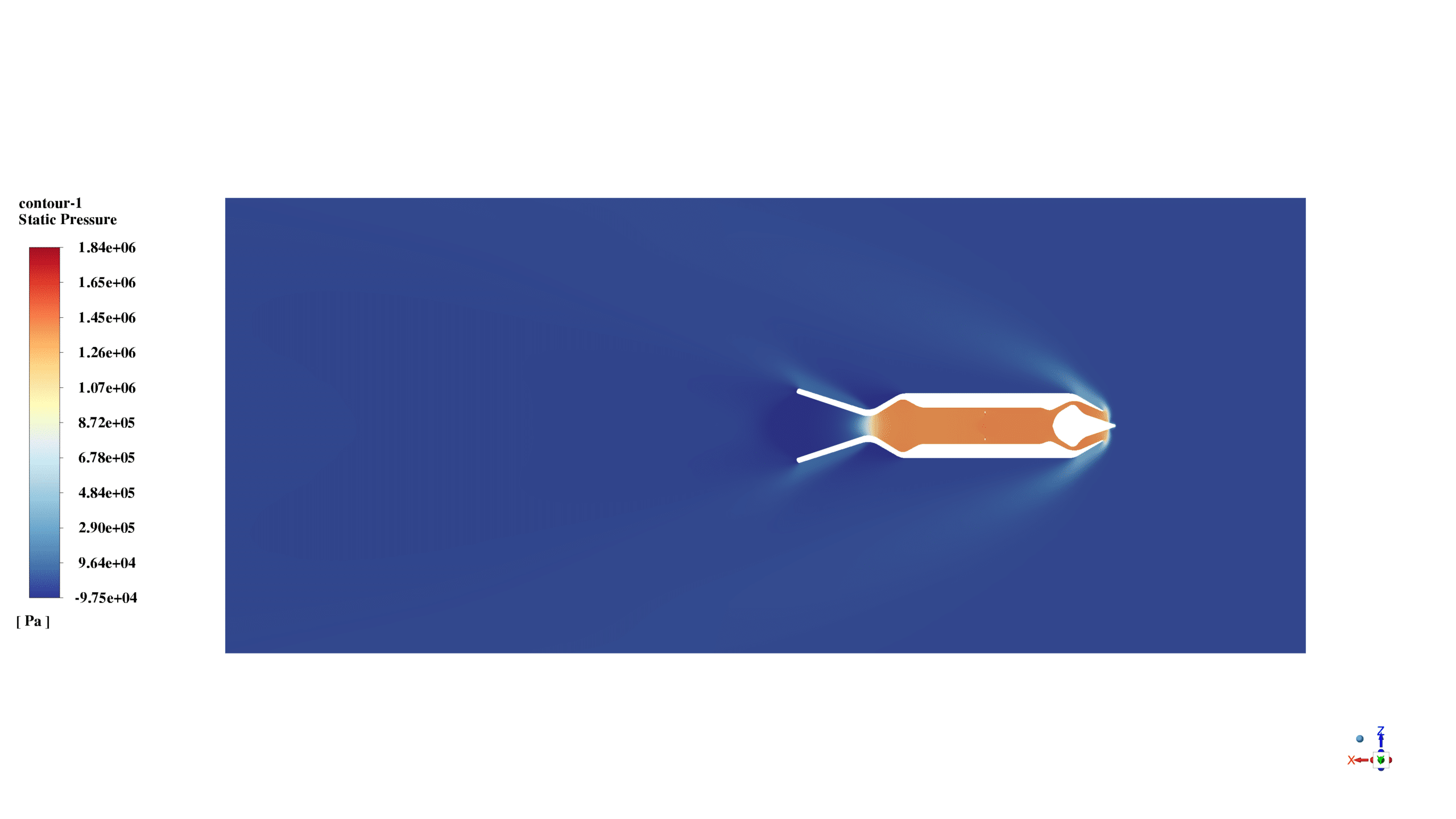
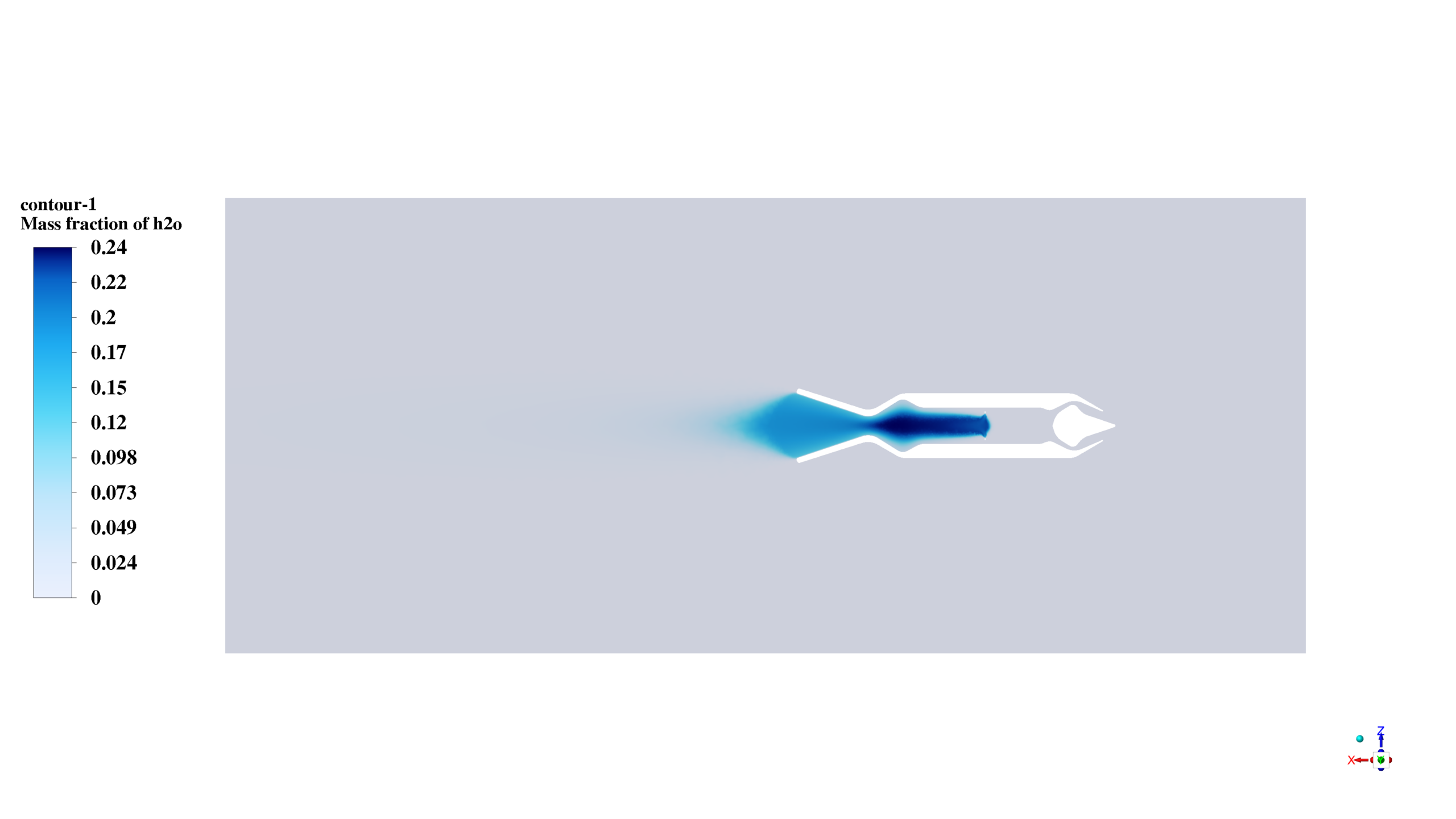
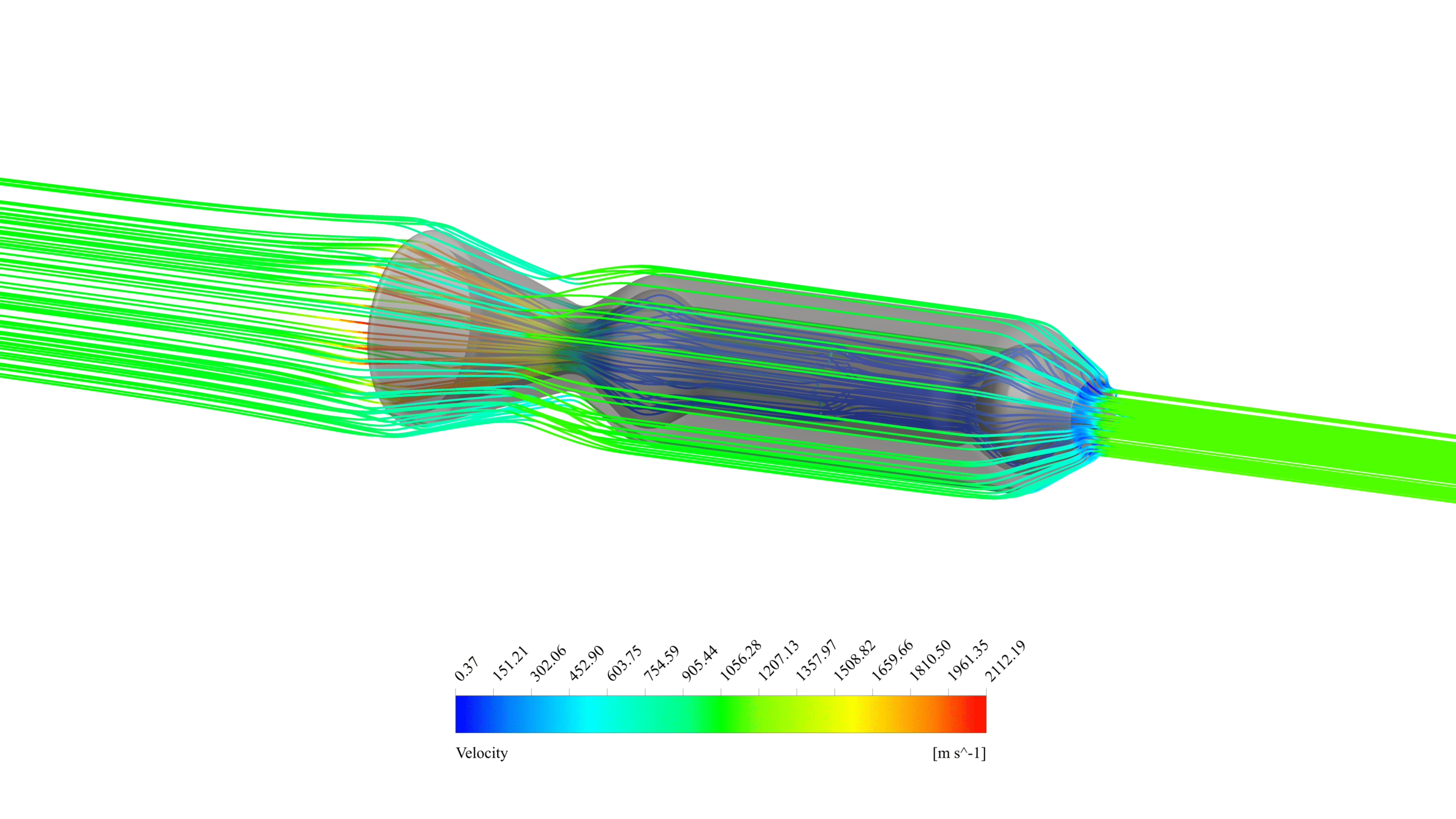
-
Optimization
In order to optimize the device performance and to get the maximum use of fuel and consequently the highest thrust number, the Design of Experiment study is carried out on the solution. 3 parameters that affect the results drastically are chosen to examine the effects of their changes. The parameters are as follows:
- Fuel mass Flow rate
- Injection angle
- The distance of the injection slot from the engine inlet
In the first simulation discussed above, parameters 1, 2 and 3 are 0.17 kg/s and 60 cm, respectively.
The optimization case has studied parameters 1 to 3 in the following range:
- 138 kg/s – 0.21 kg/s
- (-45) – (45) Degrees (Negative in opposite and positive in the direction of the airflow)
- 50 cm – 70 cm
Finally, 3D plots of the parameters and their effect on the thrust of the ramjet are achieved.
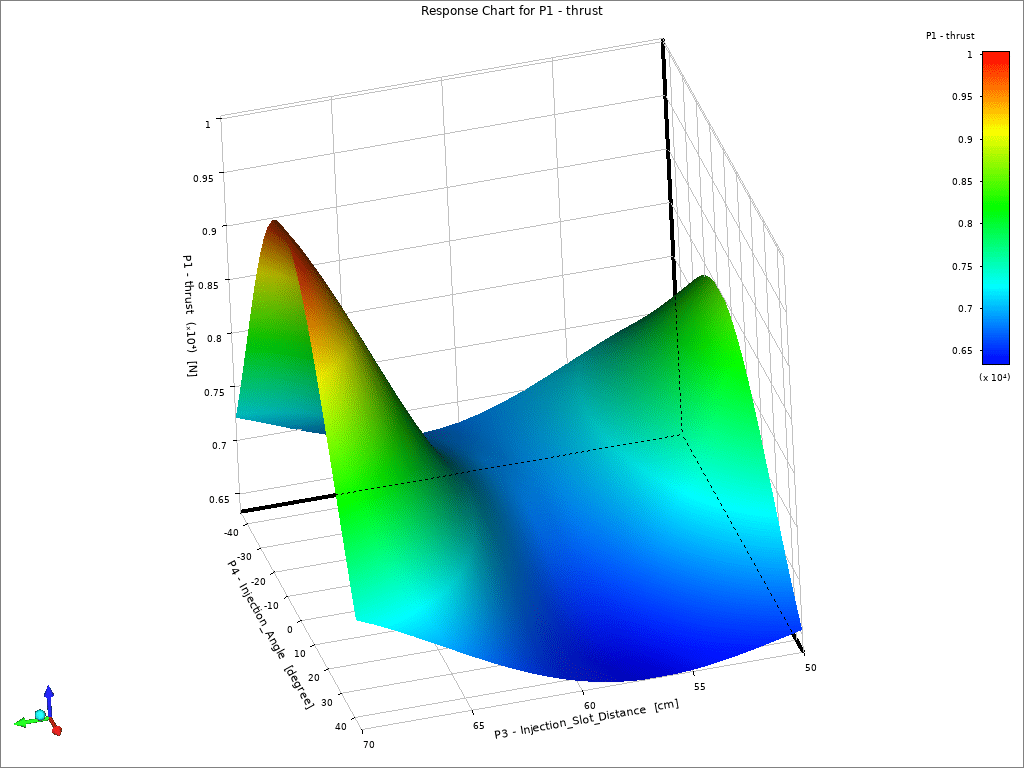
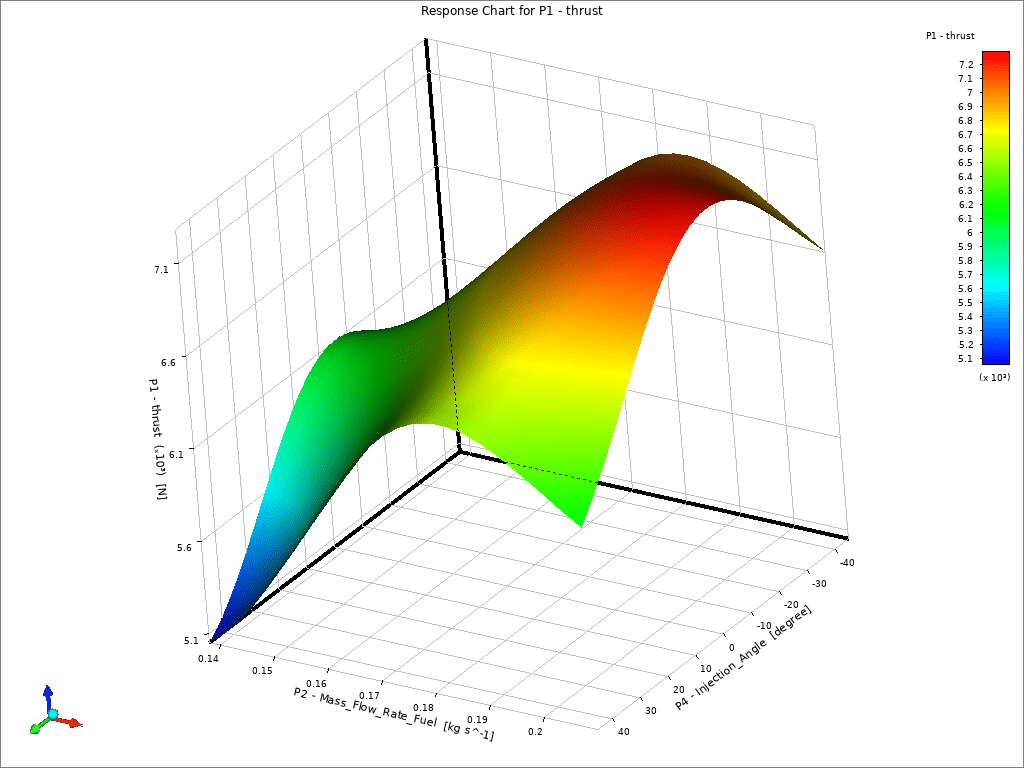
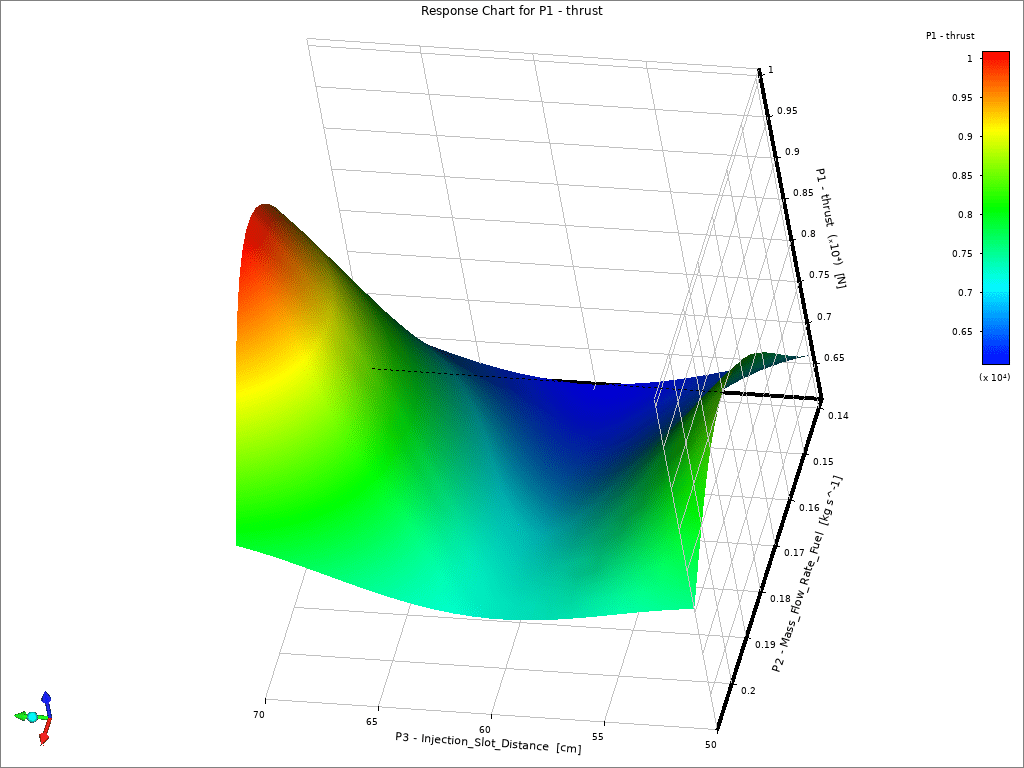
Also, the Local Sensitivity bars show the sensitivity of the output, which here is the thrust number, to each defined parameter:
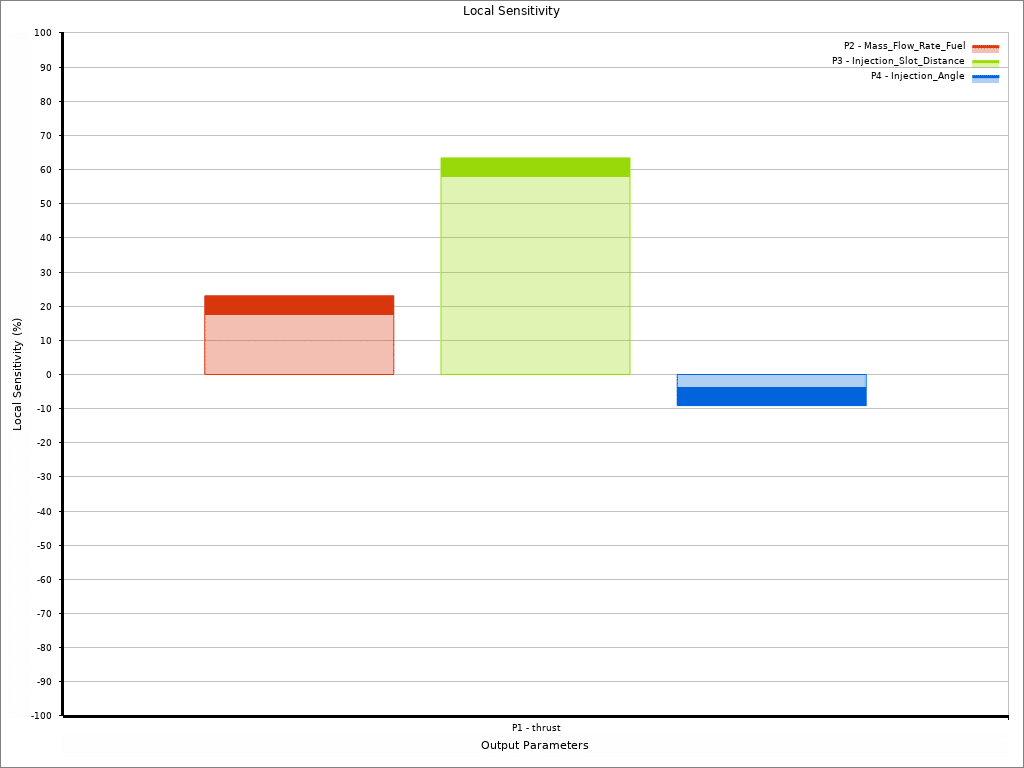
The DOE model also gave us the minimum and maximum amount of the parameters considering their interactions. The highest and lowest amount of the thrust in the carried out simulation would achieve in the following settings:
The highest Thrust number:
- Fuel mass Flow rate 0.1784 kg/s
- Injection angle 70 cm
- The distance of the injection slot from the engine inlet +0.6568 degrees
The lowest Thrust number:
- Fuel mass Flow rate 0.138 kg/s
- Injection angle 65.994 cm
- The distance of the injection slot from the engine inlet +45 degrees

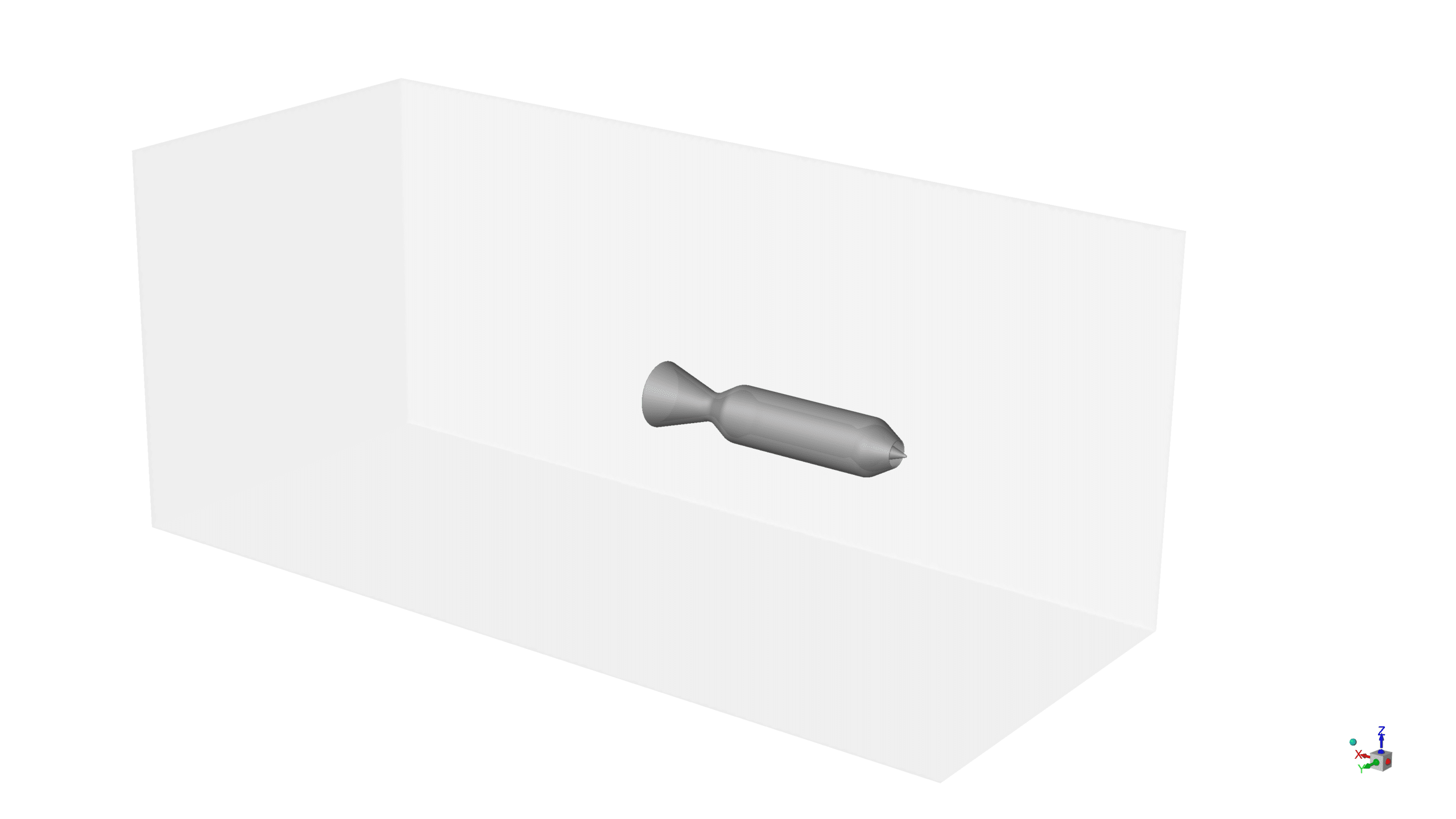
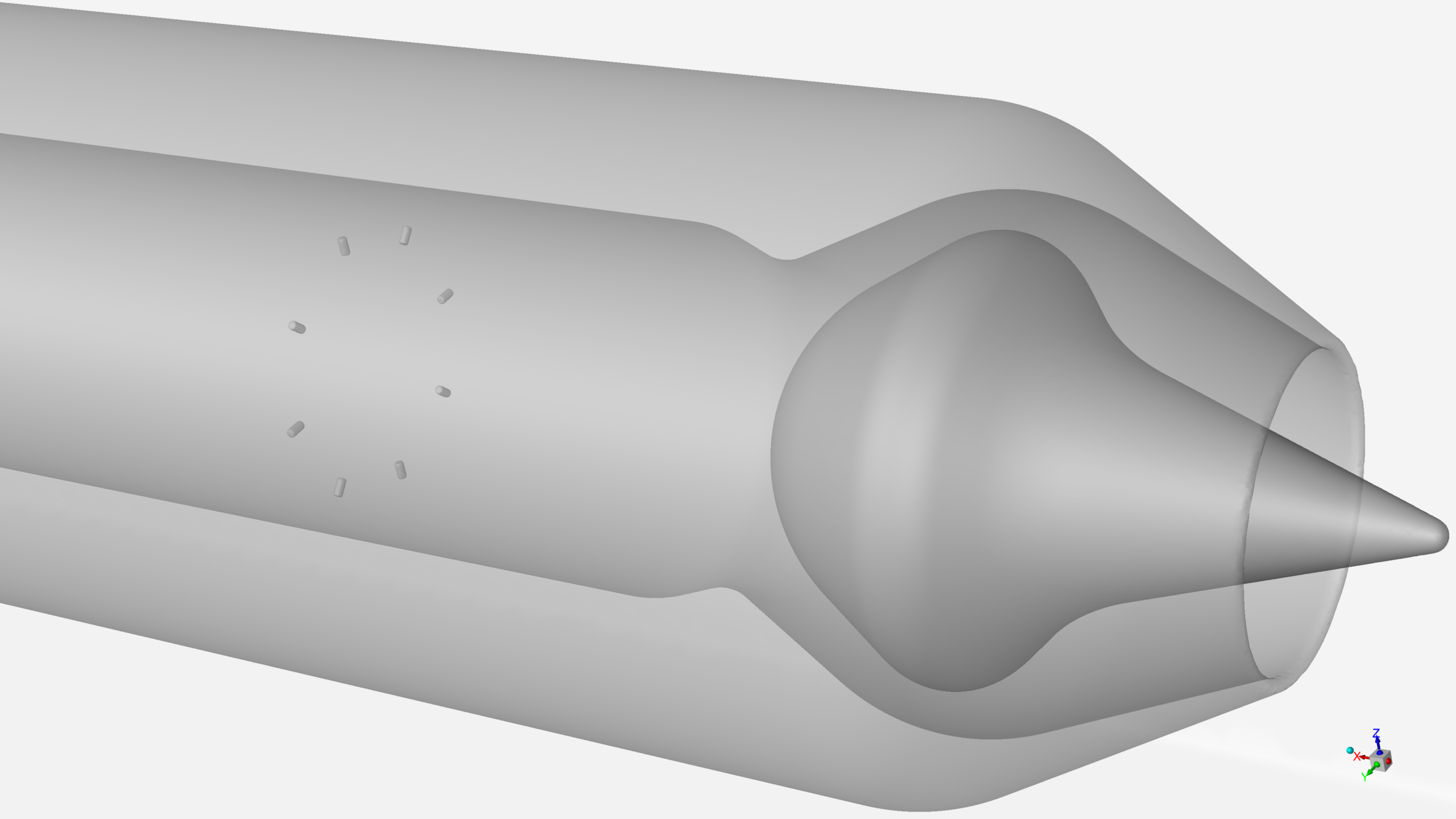
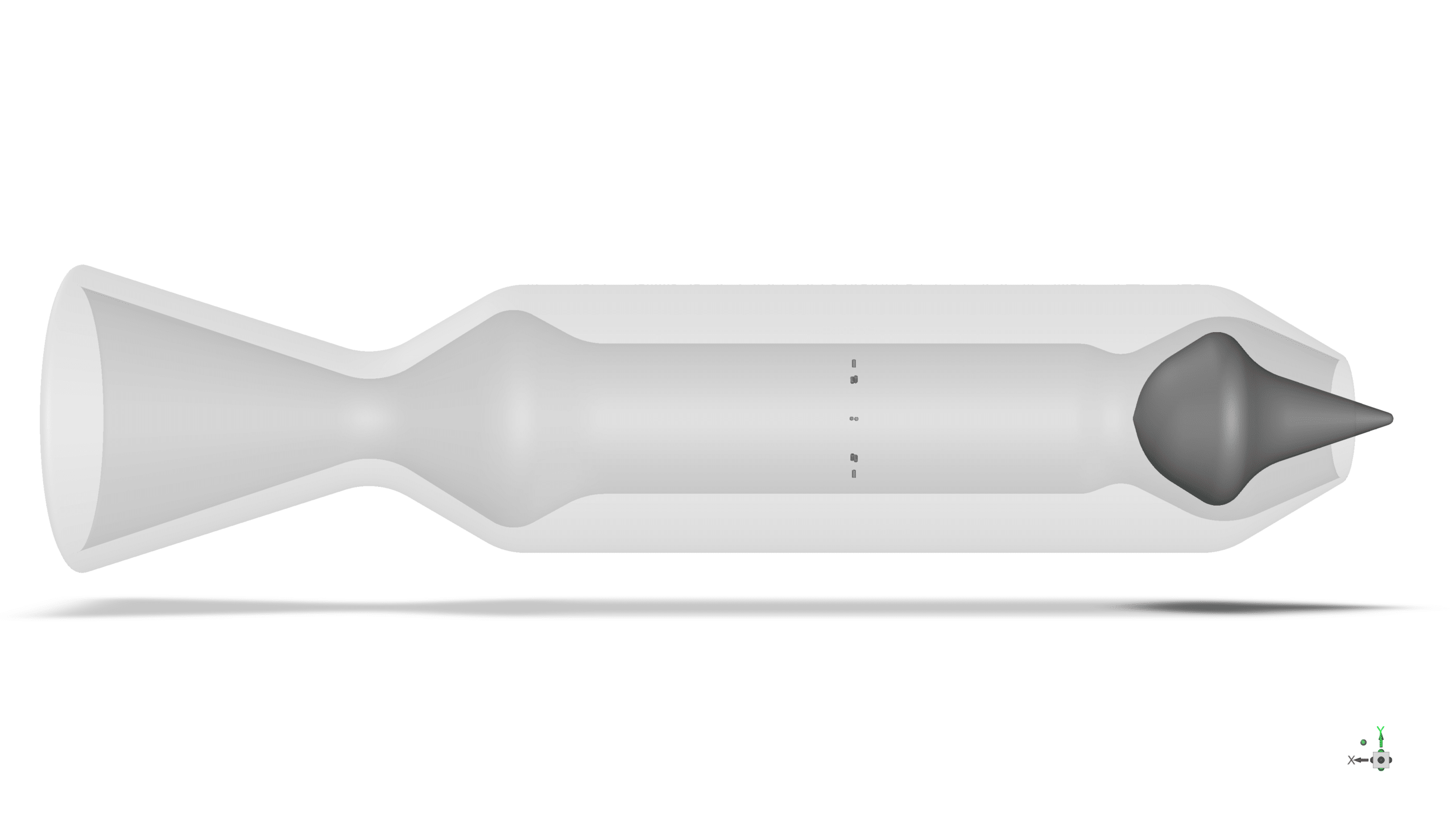

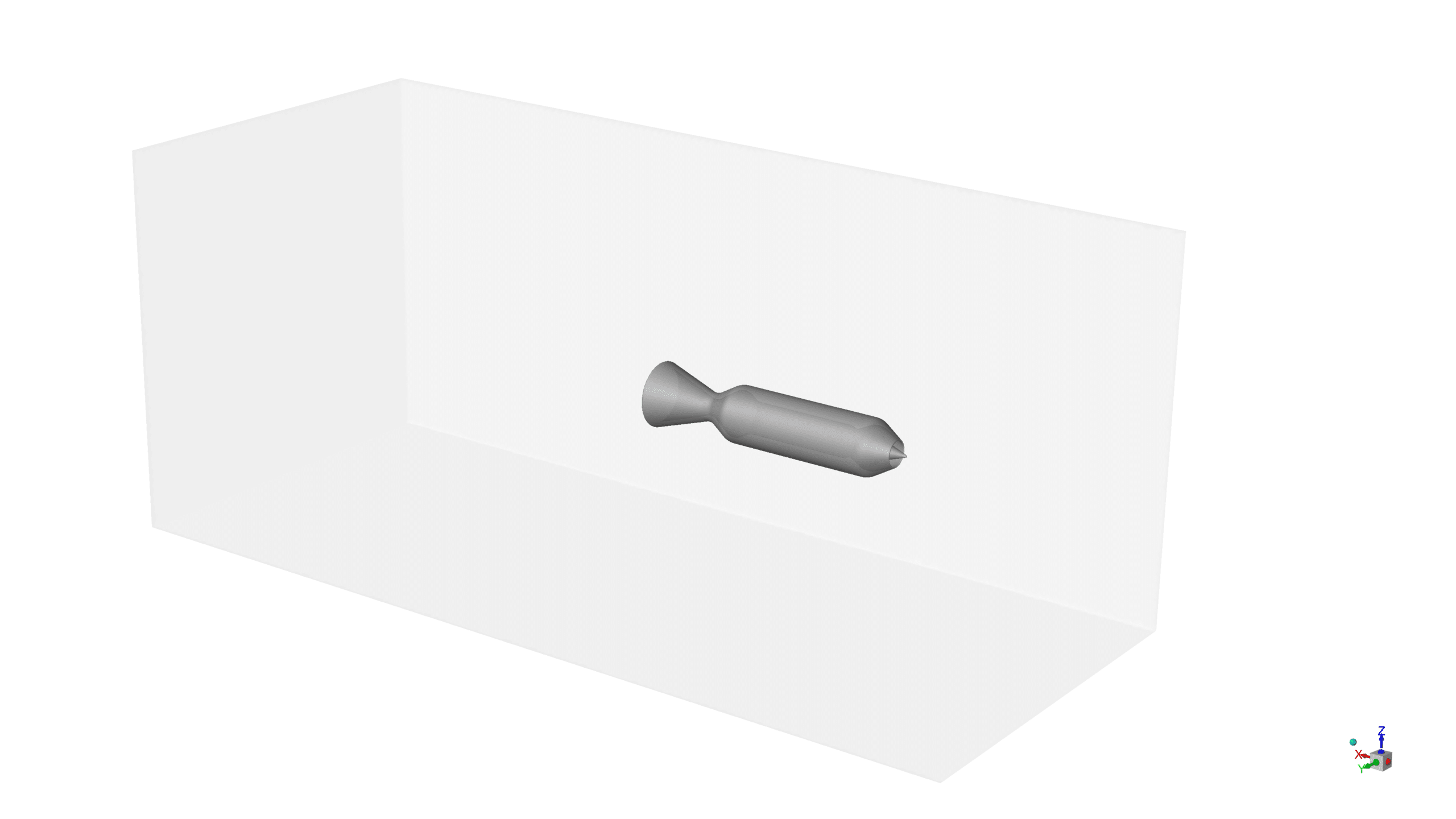
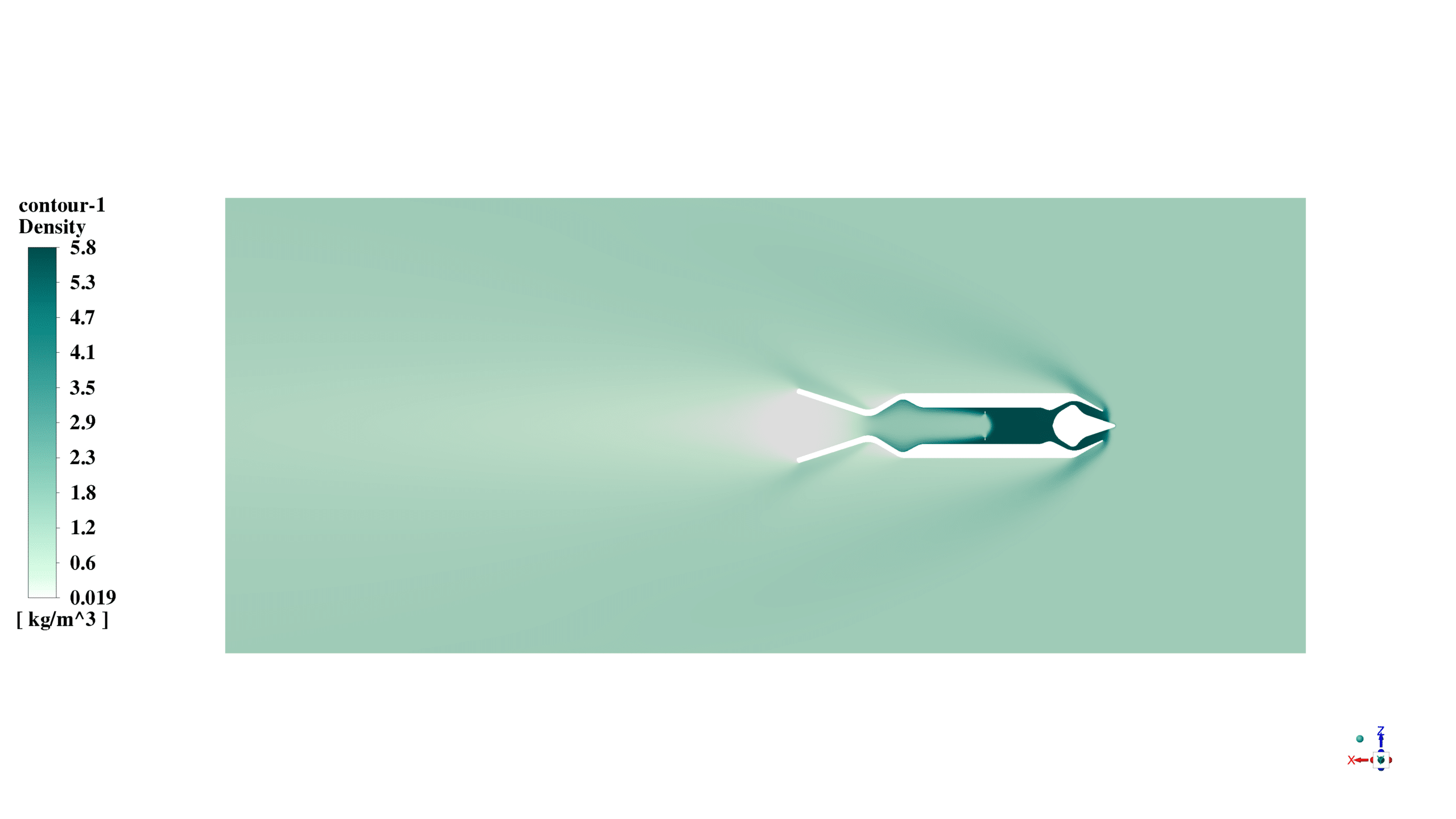
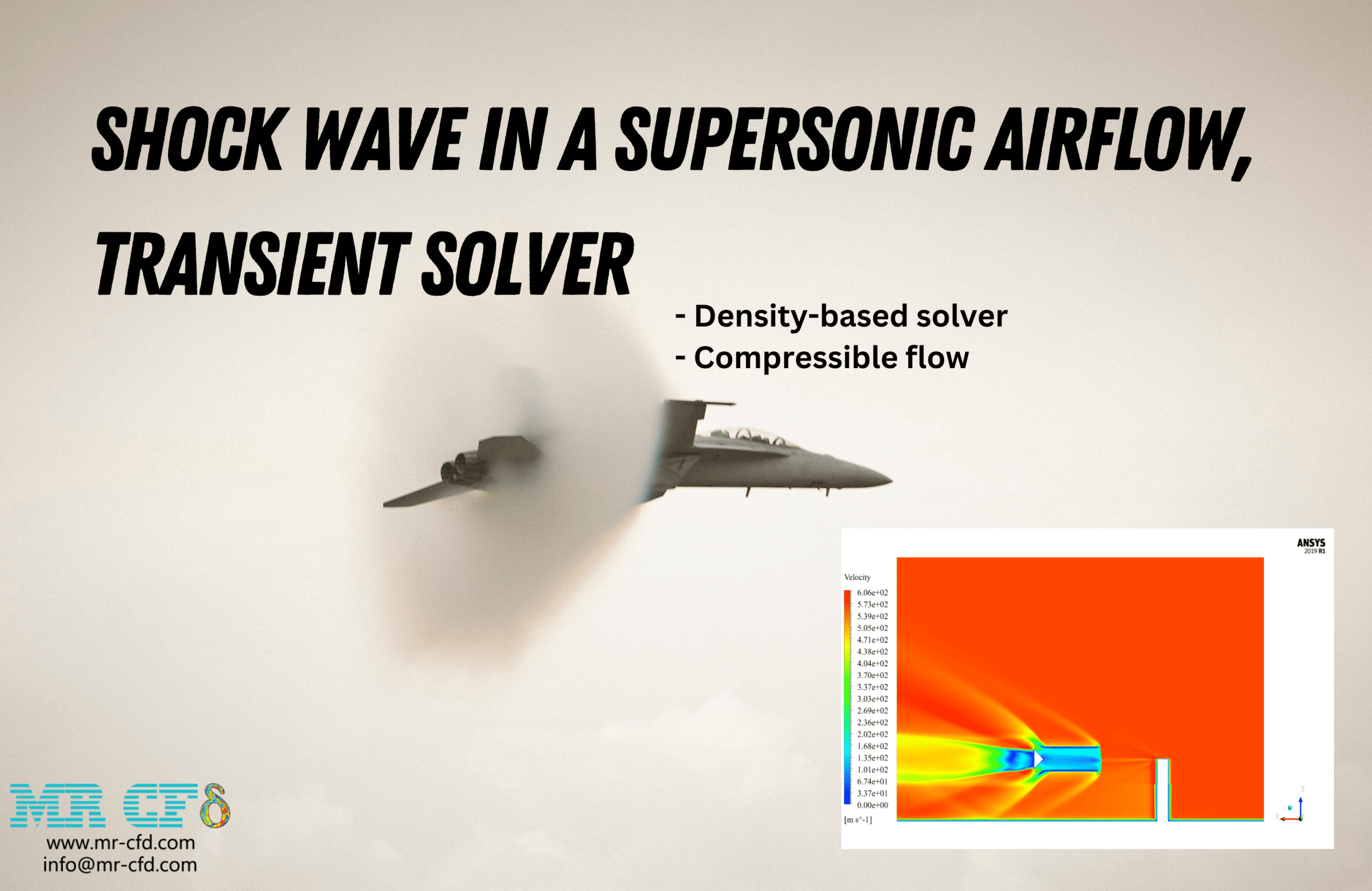
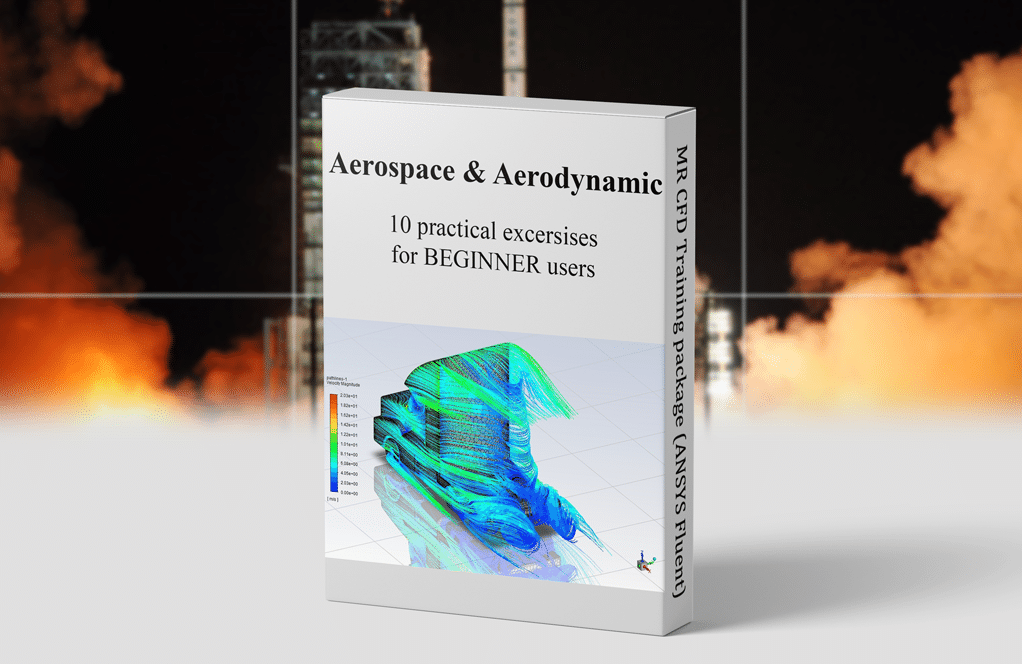
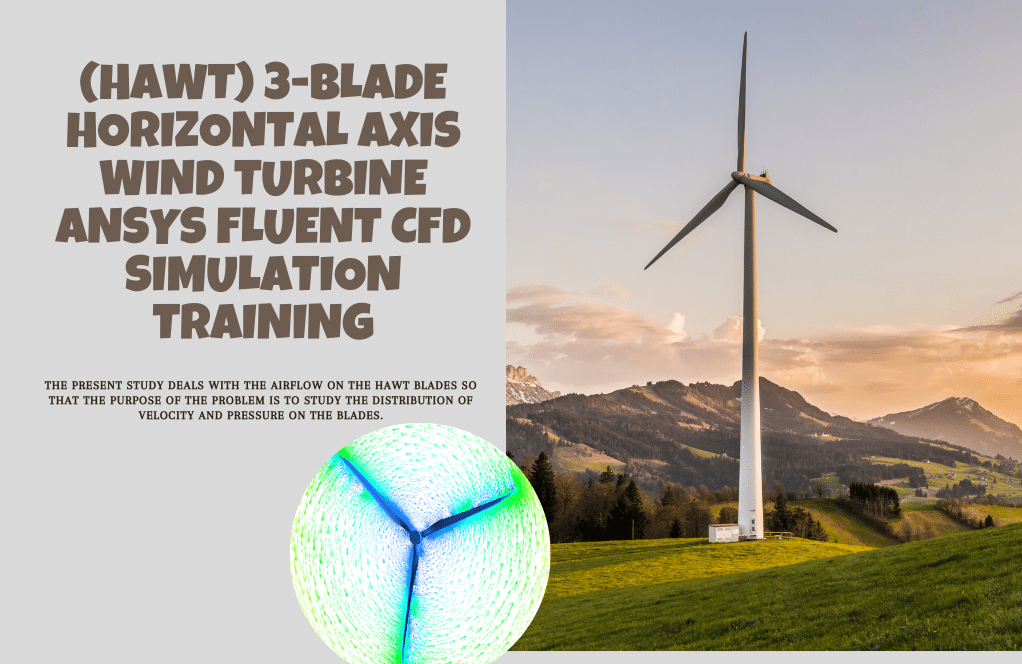
Clay Erdman –
The optimization done on the ramjet engine sounds amazing! It’s great how the study used DOE method to determine the influence of fuel flow rate, injection angle, and slot distance on the engine thrust. I’m impressed by the level of detail and the range of parameters that were explored to fine-tune the performance.
MR CFD Support –
Thank you for your kind words! We are glad that you are impressed with the comprehensive analysis and optimization work carried out on the ramjet engine. Our goal is always to inform our customers with the finest detail possible, so they understand the innovation and complex engineering that goes into creating efficient and optimized designs. If you have any more feedback or need further information about our project deliverables, we are here to help.
Rozella Sipes –
I’m interested in how the optimizer identifies the optimal fuel mass flow rate and injection angle is there a specific method it uses to find the most effective parameters for thrust enhancement?
MR CFD Support –
In the optimization process, the Design of Experiments (DOE) method is utilized to identify optimal parameters. This involves creating a matrix of simulations that systematically vary the crucial parameters: the fuel mass flow rate, the injection angle, and the distance of the injection slot from the engine inlet. By exploring the effects of these variables, the optimizer can elucidate their impacts on thrust generation. The software calculates the performance metrics for each simulation and uses these results to determine the configuration that yields the highest thrust, indicating the optimal combination of fuel flow rate and injection angle.
Kirk Runolfsdottir –
The detailed simulation work and analyses shown in the ramjet engine optimization project seem fantastic! Learning how different design parameters affect the thrust is fascinating and useful for engineering applications.
MR CFD Support –
Thank you so much for taking the time to review our Ramjet Engine CFD Simulation product. We are delighted to hear that you found the analysis and optimization of various design parameters insightful and applicable to engineering endeavours. If you have any further questions or require additional support, please feel free to reach out to us.
Sheldon Greenfelder II –
I’m impressed by the detailed simulation setup for the SR-71 Blackbird’s ramjet engine. Clarifying question: In the optimization process, what was the most influential parameter on the ramjet’s thrust, and by fine-tuning which variable happens to reach the maximum thrust?
MR CFD Support –
Based on the project description, the Design of Experiment (DOE) study reveals that fuel mass flow rate has a significant influence on the thrust produced by the ramjet engine. By optimizing the fuel mass flow rate to 0.1784 kg/s, aligning the injection slot distance from the engine inlet to 70 cm, and slightly adjusting the injection angle to +0.6568 degrees, the maximum thrust number is achieved in the simulation.
Mittie Hamill –
Can this product be used for educational purposes to help understand the principles of ramjet functioning and optimization?
MR CFD Support –
Absolutely, this product can serve as a valuable educational tool to help students and professionals alike understand the principles of ramjet engine functioning and optimization through practical and detailed simulations.
Sanford Schaden –
Could the results of the ramjet engine simulation have implications for improving the performance of existing jet-propelled aircraft, and if so, how might designers apply these insights?
MR CFD Support –
Yes, the implications of ramjet engine simulation results can certainly guide improvements in jet-propelled aircraft designs. Designers could seek to apply optimization analysis similar to the DOE performed for this study. Insights regarding the optimal fuel mass flow rate, injection angle, and distance of injection slot from the engine inlet directly impact engine efficiency and thrust. These insights can steer advancements in fuel efficiency, thrust generation, and overall engine performance, contributing to the development of more effective and economical aircraft.
Aidan Smith –
The optimization results are fascinating! Could this model be further utilized to simulate ramjet engines operating at different Mach numbers beyond Mach 5 for hypersonic flight conditions?
MR CFD Support –
Thank you for your positive feedback! Although this particular simulation focused on a Mach number of 3.3, adapting the model to explore ramjet engine operation at hypersonic speeds (Mach numbers beyond 5) can certainly be considered for future simulations. Higher Mach numbers present unique challenges such as increased thermal loads and complex fluid dynamics which may require modifications to the current simulation approach and further computational resources.
Bryana Pfannerstill –
Which factors in the ramjet combustion optimization played the most crucial role for the SR-71 Blackbird based on the DOE study?
MR CFD Support –
According to the results of the Design of Experiment study, the Local Sensitivity bars indicate that the thrust number is highly sensitive to changes in the fuel mass flow rate and the injection angle. The interaction of these factors alongside the distance of the injection slot from the engine inlet was studied, giving practical insights into achieving the most efficient thrust. All three parameters play crucial roles, yet the fuel mass flow rate and injection angle appear to have a more pronounced effect on the overall performance according to the DOE analysis.
Dr. Demario Aufderhar DDS –
Fantastic detail on the Ramjet Engine optimization! Wondering, how does the varying Mach number affect the overall performance and optimization results?
MR CFD Support –
Thanks for your compliment! In regards to varying Mach numbers, higher velocities generally lead to stronger shockwaves in the air inlet which can affect engine efficiency. As the vehicle goes supersonic, inlet design to slow down air becomes crucial. Beyond Mach 5, ramjet efficiency decreases and different propulsion methods may be needed. In our simulations, we focus on a specific Mach number of 3.3 to tailor and optimize engine performance parameters such as fuel mass flow rate, and injection angle, specific to SR-71 flight conditions.
Lester Hermiston –
I found the details about the ramjet design, combustion optimization and the use of DOE method fascinating. The explanations of variations in the thrust number are particularly informative as they describe how altering parameters can precisely enhance engine efficiency.
MR CFD Support –
We are thrilled to hear you enjoyed the explanation of the ramjet engine simulation project! It’s great that you found the optimization information useful. Thank you for your kind review, and we’re glad our product could provide valuable insights into combustion analysis and performance improvement.
Lionel Marks Jr. –
In this CFD simulation and optimization for the ramjet engine, what was the specific reason for choosing hydrogen as the fuel?
MR CFD Support –
Hydrogen was chosen as the fuel for the ramjet engine in this simulation due to its advantageous properties at high Mach numbers. Hydrogen has a relatively short inflammation delay and results in higher efficiency and performance when the air’s overall temperature is high, which is the case at supersonic speeds like Mach 3.3. These properties make hydrogen particularly suitable for high-speed air-breathing engines like ramjets.
Stone Ullrich II –
The fuel optimization using DOE seems quite thorough. Have the optimal parameters been implemented into the final design, and if so, what improvements in performance were observed compared to the initial design?
MR CFD Support –
In fact, once the DOE analysis provided the optimal parameters for the ramjet engine, these were implemented into the final design. By adjusting the fuel mass flow rate, injection angle, and distance of the injection slot based on the DOE findings, notable improvements were made. Specifically, the thrust performance of the ramjet engine for the SR-71 Black Bird increased. The optimized design achieved higher efficiency and better fuel usage, implying enhanced overall performance.
Louvenia Morissette –
What a great example of aerodynamics and engineering ingenuity applied to computational simulations! The detailed process of optimization for the SR-71 Blackbird’s ramjet engine clearly demonstrates the sophistication and necessity of using CFD in improving complex systems. Real-world implications of such simulations ensure efficient and enhanced performance in critical applications. Excellent work by MR CFD Company.
MR CFD Support –
We truly appreciate your kind words and recognition of the work done on the SR-71 Blackbird’s ramjet engine simulation. It’s gratifying to know that our efforts to use advanced CFD techniques for optimizing such a complex system have met with your approval. Thank you for your thoughtful review, and we look forward to continuing to provide high-quality simulation products and services.
Vernice Moen –
The project on optimizing a ramjet engine is informative. Your CFD analysis and exploration of parameters like the injection slot distance provide valuable insight into engine performance. It shows a thoughtful scientific approach with practical implications for aviation technology.
MR CFD Support –
Thank you for the appreciation! We’re pleased to hear that our efforts to optimize the ramjet engine design and its combustion through CFD analysis were insightful and useful. We aim to provide accurate and meaningful information that contributes to advancements in technology. If there is any specific aspect of the project you are particularly interested in or if you have further queries, please feel free to reach out.
Katlyn Koepp –
I’m deeply impressed by the successful application of DOE optimization. What are the benefits of using hydrogen as fuel for high-speed supersonic flights like that of the SR-71?
MR CFD Support –
Hydrogen is an excellent choice for high-speed supersonic flights for several reasons. It has a high specific energy per unit mass, which enables a greater energy yield compared to traditional jet fuels. Additionally, at high Mach numbers, the high overall temperatures make hydrogen advantageous due to its relatively short inflammation delay, meaning it ignites and burns quickly and efficiently. This can result in enhanced thrust and better overall performance for aircraft operating at these extreme speeds.
Jayda Reinger –
Which specific parameters were adjusted during the optimization to improve the ramjet engine’s thrust?
MR CFD Support –
During the optimization process, the following three parameters were adjusted: 1) The fuel mass flow rate, which was varied between 0.138 kg/s and 0.21 kg/s, 2) The injection angle, ranging from -45 to +45 degrees, and 3) The distance of the injection slot from the engine inlet, which was adjusted between 50 cm and 70 cm. These parameters were carefully examined to achieve the highest possible thrust from the ramjet engine.
Prof. Idella Jast III –
This simulation sounds impressive! I’m curious to know how the Design of Experiment method contributes to finding the optimal operational parameters for the ramjet engine. Can you provide insights into this process, please?
MR CFD Support –
Certainly! The Design of Experiment (DOE) method in this context systematically varies the three crucial engine parameters within a specified range to measure their effect on thrust generation. By exploring different combinations of fuel mass flow rate, injection angle, and distance of the injection slot from the engine inlet, the DOE helps identify the most efficient configuration for maximum thrust. This process uses statistical techniques to decipher complex interactions between parameters and determine optimal settings, which are crucial for the performance enhancement of the ramjet engine.
Camille Crooks –
I learned a lot from the SR-71 Black Bird ramjet engine simulation optimization. I’m interested to know how changing the fuel mass flow rate impacts the combustion and thrust relative to the other parameters.
MR CFD Support –
In the optimization process for the SR-71 Black Bird ramjet engine simulation, varying the fuel mass flow rate affects the combustion efficiency and consequently the thrust. A higher fuel mass flow rate provides more reactant in the combustion process, which can increase the thrust if the mixing and burning are optimal. Conversely, too high a fuel mass flow can also lead to incomplete combustion if the oxygen availability is insufficient, which may reduce efficiency. Its impact is analyzed alongside other variables like the injection angle and the distance of the injection slot from the engine inlet, to optimize the engine performance for the highest possible thrust. The balance between fuel supply and efficient combustion is crucial, and the specified ranges of fuel mass flow rate are systematically studied to find the setup yielding the best propulsion results.
Emmanuelle Predovic I –
Was the simulation for the ramjet engine conducted as 2D or 3D, and how does this choice affect the results?
MR CFD Support –
The simulation of the ramjet engine, as stated in the project description, involved both 2D and 3D elements. The 2D contours provided visualizations of velocity, temperature, static pressure, density, and mass fraction, while the 3D plots were used to analyze the impact of the variables on the thrust. Conducting portions of the simulation in 2D can help in simplifying the analysis and reducing computational efforts; however, it might limit the accuracy compared to a full 3D simulation, which can capture the complexities of the flow in all directions and offer more detailed insights about the engine’s performance.
Monserrate Toy –
I’m fascinated by how the DOE method helps in optimization. Could you please clarify which optimization strategy was used and why this particular method was chosen for the ramjet engine design?
MR CFD Support –
The Design of Experiments (DOE) method is used to optimize the inputs for the ramjet engine design. Specifically, it helps explore relationships between various input parameters and analyze their effect on the output (thrust). DOE allows for a systematic and efficient investigation of the input-output relationship by changing these parameters methodically. For the ramjet engine case of SR-71 Blackbird, DOE arguably provided a comprehensive insight into how factors like fuel mass flow rate, injection angle, and the distance of the injection slot from the engine inlet affect performance, which was essential for achieving the optimal engine design and combustion efficiency.
Margarete Dare –
The learning material presents thorough insights into ramjet engine simulations. Particularly impressed by the optimization section that utilized DOE principles effectively!
MR CFD Support –
Thank you for your positive feedback! We’re thrilled to hear that our product on ramjet engine design and combustion optimization met your expectations and provided you with in-depth knowledge. We strive to deliver content that helps enthusiasts and professionals alike. Your appreciation for the DOE optimization section encourages us to keep up the great work!
Prof. Gage Durgan DDS –
What an interesting subject on the ramjet engine design and its optimization! It’s incredible how MR CFD’s simulation captures the combustion process’s complexities and the importance of parameter interactions. The clarity in how the DOE method is applied to optimize the engine performance is particularly educating. I’m fascinated by how different combinations of fuel mass flow rate, injection angle, and injection slot distance can vary thrust significantly. Great work MR CFD on providing such comprehensive analysis!
MR CFD Support –
Thank you for your positive feedback! We are thrilled to hear that our analysis of the ramjet engine provided you with a clear understanding of the combustion process and optimization using the DOE method. Your enthusiasm for the details of the simulation and appreciation for the educational aspect of our work is much appreciated! Thank you for taking the time to share your thoughts. If you have any further questions or need more information, feel free to ask.
Vicente Walsh –
Excellent course content exploring the intricate modeling and optimization of a ramjet engine. Perfect mix of practical application and advanced simulation to push my understanding of aerospace engineering further!
MR CFD Support –
Thank you for your kind words! We’re thrilled to hear that our course on the ramjet engine model and optimization was both informative and valuable in advancing your knowledge in aerospace engineering. Your enthusiasm for the content genuinely motivates us to continue providing high-quality learning materials. If you have more feedback or need any further information on our courses, feel free to reach out.
Mrs. Jenifer Bradtke –
I purchased the ‘Ramjet Engine, Design and Combustion Optimization (SR-71 Blackbird), Industrial Application’ course and went through the simulations. The step-by-step approach was intuitive, and calculations for the ramjet’s performance were enlightening. Could you clarify how the transition from subsonic to supersonic combustion is treated in the simulation?
MR CFD Support –
In the simulation, the transition from subsonic to supersonic combustion is addressed by progressively decelerating the incoming airspeed through the aircraft inlet, which creates a series of shock waves. These shock waves are simulated and well-managed within the combustion chamber to guarantee that the combustion process at the given mach number continues at subsonic speeds which indicates successful management of flow dynamics. Proper setup of boundary conditions and numerical methods ensure the accurate capturing of such complex flow transitions within the ramjet engine simulation.
Ms. Gabrielle Ziemann Jr. –
I’m impressed with the detailed analysis and optimization process for the SR-71 Blackbird ramjet engine using ANSYS Workbench. The DOE method seems particularly well-suited for identifying the most efficient operating parameters and sensibilities to obtain maximum thrust. Great work by MR CFD on a complex and advanced topic!
MR CFD Support –
Thank you for recognizing the complexities handled in the SR-71 Blackbird ramjet engine simulation and the value of employing the Design of Experiment (DOE) method. Your feedback is greatly appreciated, and we are delighted to hear that the work exceeded your expectations. Ensuring our analysis is both thorough and useful for advanced aerospace applications is a commitment we take seriously. If you have any more questions or need further assistance, please don’t hesitate to ask. Thank you! -MR CFD Team
Bryana Connelly –
I’m amazed by the detailed analysis of the SR-71 Blackbird’s ramjet engine. Could you explain a bit about how the DOE method contributes to the optimization of the engine’s performance?
MR CFD Support –
The Design of Experiment (DOE) method in the optimization process was used to systematically evaluate the relative influence of various parameters like fuel mass flow rate, injection angle, and the distance of the injection slot from the engine inlet on the engine’s performance. By assessing the engine performance at different levels of these parameters, the DOE helps to identify the optimal combination that maximizes thrust while ensuring efficient fuel usage. From the analysis provided, the optimized parameters were also discovered. This approach greatly assists engineers in making informed decisions based on a structured experiment, rather than just trial and error.
Dr. Vicenta Blanda –
I was very impressed with the detailed analysis of the ramjet engine performance optimization for an SR-71 Blackbird! The use of DOE for parameter study and the thorough examination of the fuel injection process is commendable. I believe the clear visuals and sensitivity analysis must have provided great insights for combustion enhancement and fuel efficiency improvement. Fantastic work!
MR CFD Support –
Thank you for your kind words and positive feedback on the ramjet engine analysis and optimization project. We are delighted to hear that you were able to appreciate the depth and clarity of the investigative work that went into this, as well as the visual aids and sensitivity analysis. It’s gratifying to know that our efforts to enhance understanding and improve performance are valuable to our customers. We look forward to continuing to provide high-quality CFD solutions to our users. Thank you for choosing MR CFD Company’s learning products!
Dr. Bo Medhurst –
The insights from the DOE study of the ramjet engine simulation seem fascinating. Could you please explain how changes in the injection angle influence the performance and thrust of the ramjet engine?
MR CFD Support –
Change in the injection angle affects the interaction between the injected fuel and incoming air, which influences mixing efficiency, combustion, and thus the thrust. An optimal angle improves mixing and combustion, enhancing thrust. Angles too far off the optimal can impede efficient fuel-air mixing, potentially leading to reduced thrust and performance losses.
Ethyl Gaylord –
I was fascinated by the ramjet engine optimization analysis for the SR-71 Blackbird. The variety of parameters tested and their effects on engine thrust is impressive. Great visualization of data and clear explanation of the impact of each parameter.
MR CFD Support –
Thank you for your positive feedback! We’re delighted that the ramjet engine optimization analysis was informative and that the visualizations added clarity to the study’s findings. It’s gratifying to know our work is appreciated and aids in better understanding the complexities of jet engine performance. If you have any further inquiries or need assistance, feel free to reach out!
Dr. Orpha Upton Jr. –
This ramjet engine simulation is fascinating! What kind of optimization algorithms does the DOE method employ in ANSYS Workbench to find the optimal parameters?
MR CFD Support –
In ANSYS Workbench, the DOE method utilizes several optimization algorithms such as full factorial, fractional factorial, central composite, Box-Behnken, and response surface optimization to determine the effect of different parameters on the simulation results. The best algorithm choice might depend on the specifics of the problem, the number of parameters, and the desired resolution of the study. These algorithms help to explore the design space systematically and efficiently, leading to the identification of optimal configurations.
Imogene Wuckert –
I’m interested in the impact that the fuel mass flow rate has on the performance of the ramjet engine. How does varying this parameter influence the thrust produced by the engine?
MR CFD Support –
The fuel mass flow rate directly affects the combustion efficiency and, consequently, the thrust produced by the ramjet engine. By adjusting the fuel mass flow rate, you essentially control the amount of energy that can be released through the combustion process. A higher mass flow rate allows for more fuel to be combusted and more thrust to be generated, up to the point where the fuel-air mixture remains optimal. If the mass flow rate exceeds the capacity for efficient mixing and combustion, it could lead to fuel-rich areas that don’t contribute to thrust production and instead may cool the engine and reduce efficiency. Hence, there is an optimized range for the fuel mass flow rate to produce the highest thrust.
Mr. Adriel Leuschke –
This product has significantly deepened my understanding of ramjet engine operations and optimization. The explanation of the DOE parameters and their implications for thrust performance was extraordinarily helpful. By applying these optimization insights, I’ve improved conceptual designs for related projects.
MR CFD Support –
Thank you for your positive feedback! We’re thrilled to hear our ramjet engine simulation and optimization product has been so helpful in advancing your projects. We always strive to provide detailed and useful analysis to foster better understanding and application. Keep us posted on your future breakthroughs!
Dr. Arlo Rogahn –
I’m very interested in the level of detail you’ve put into this project. Could you possibly tell me more about the initial computational mesh setup and how was it refined to achieve accurate results especially around the fuel injection slot and combustion regions?
MR CFD Support –
For this simulation, the initial computational mesh was designed to be finer around regions with expected high gradients, such as the injection slots and combustion zones. Adaptive mesh refinement techniques were likely employed during the simulation to dynamically refine the grid in response to evolving flow features, improving the accuracy of the results in these critical areas.
Mr. Gideon Okuneva –
The optimization results provided are fascinating! Could you elaborate on how the optimized parameters influence each other and the overall performance of the engine?
MR CFD Support –
Thank you for your positive feedback! The optimized parameters are interconnected, affecting the combustion efficiency and total thrust output of the ramjet engine. Variations in the fuel mass flow rate, the angle of fuel injection, and the position of the injection slot relative to the engine inlet each have a significant impact on how the fuel mixes with the incoming airflow, the completeness of combustion, and the distribution of temperature and pressure within the combustion chamber. Adjusting these parameters through the Design of Experiment (DOE) method allows for fine-tuning to achieve the best balance between fuel consumption and engine thrust, ultimately enhancing performance in a ramjet-powered aircraft like the SR-71 Blackbird. Adjusting the injection angle and slot distance optimizes the interaction between the introduced fuel and the shock waves present in supersonic airflow, which is critical for maximizing thrust and minimizing drag.
Dr. Rashad Hayes –
What an informative review of the SR-71 ramjet engine design and optimization! The careful simulation of this advanced propulsion system and its subsequent optimization through DOE methodology highlight the capabilities and complexity involved in high-speed aircraft operations. I appreciate the detailed explanation of the various parameters and their impact on the engine’s performance.
MR CFD Support –
Thank you for your kind words! We are delighted to hear that you appreciated the depth of the analysis on the SR-71 Blackbird’s ramjet engine. Our goal is to consistently provide comprehensive and intricate simulations that can aid in understanding and improving complex engineering systems. We look forward to continuing to serve your curiosity and interest in CFD applications.
Drake Kuhlman –
I found the section about optimization particularly interesting. Could you elaborate on how the DOE method aids in enhancing the thrust of the ramjet engine used in the SR-71 Blackbird simulation?
MR CFD Support –
In optimizing the thrust of the ramjet engine, the Design of Experiment (DOE) method systematically changes and analyzes three critical parameters: the fuel mass flow rate, injection angle, and distance of the injection slot from the engine inlet. By adjusting these parameters across a predefined range and conducting multiple simulation runs, DOE identifies how each affects engine performance. This method uncovers the precise combinations that maximize thrust, leading to a more efficient and powerful engine. Local sensitivity analysis further breaks down the impact of each parameter on thrust, guiding future design improvements.
Mr. Ellis Wolff –
I just finished my project utilizing your Ramjet Engine CFD Simulation for an SR-71 Blackbird design. The process was intriguing and detailed. Seeing the velocity and temperature contours helped me understand the fluid dynamics inside the engine immensely. The optimization results were impressive.
MR CFD Support –
We are delighted to hear about your successful project and that you found the velocity and temperature contours in our Ramjet Engine CFD Simulation valuable in understanding the internal fluid dynamics. Thank you for recognizing the benefits of the optimization features as well. Your feedback is very much appreciated!
Dakota Eichmann –
I was really fascinated by the way the fuel injection angle affected the thrust. Can you tell me how modifying the angle influences engine performance in the ramjet model?
MR CFD Support –
Admin Response:
Dr. Melyssa Beatty –
What a comprehensive study! The level of detail offered in methods and outcomes makes the MR CFD product very impressive for learning about ramjet engine optimization. Cheers to the team for an excellent learning resource.
MR CFD Support –
Thank you for your kind words! We’re thrilled to hear that you’re impressed with our ramjet optimization study and finding it helpful for your learning experience. Your feedback is greatly appreciated and motivates us to continue providing high-quality learning materials.
Mrs. Elvie Cummerata –
I’m really impressed by the level of detail in the results of the Ramjet Engine design and combustion optimization especially how the Design of Experiment (DOE) method was utilized effectively. The 3D plots showing the impact of different parameters on the thrust of the ramjet were particularly illuminating, as were the exploration of variables like fuel mass flow rate, injection angle, and the position of the injection slot. Nice work!
MR CFD Support –
Thank you for your positive feedback. We take pride in providing detailed analyses and are thrilled to hear how much you appreciated the in-depth approach, particularly the use of the DOE method, to optimize our ramjet design. Our goal is to always deliver valuable insights to our clients, showing clear effects of various parameters on engine performance. Stay tuned for more advanced CFD simulations!
Roma Stanton –
The efforts and detail in the ramjet engine optimization for the SR-71 Blackbird are impressive! It’s amazing how fine-tuning parameters like the fuel mass flow rate and the injection angle can have such a significant impact on thrust. The use of hydrogen as fuel considering its short inflammatory delay at high temperatures appears to be a well-thought-out choice for such high-speed applications. In-depth computational simulations like this underscore the crucial role of CFD in advancing aerospace technology.
MR CFD Support –
Thank you for your kind words! We are thrilled to see that you appreciate the complexity and the depth of the analysis performed in the ramjet engine optimization project. Our team works diligently to ensure the accuracy and relevance of our simulations to contribute to advancements in aerospace engineering. Your recognition of the significance of these parameters and the choice of hydrogen fuel in such high-speed applications is highly valued. Comments like yours motivate us to keep delivering high-quality CFD studies and simulations.
Dr. Darien Wunsch –
Which parameters were found to be crucial for designing and optimizing the SR-71 Blackbird ramjet engine, according to the project description?
MR CFD Support –
The crucial parameters for designing and optimizing the SR-71 Blackbird ramjet engine, as identified in the project description, are the fuel mass flow rate, injection angle, and the distance of the injection slot from the engine inlet. These were selected and assessed using the Design of Experiment (DOE) method to understand their effects on engine performance and thrust optimization.
Issac Swift Jr. –
Just wanted to say this was an incredibly detailed simulation of the Ramjet Engine for the SR-71! The optimization study using DOE for parameters like fuel mass flow rate, injection angle, and slot distance was particularly insightful. It’s quite fascinating to see how these parameters can drastically affect the engine’s performance and thrust output. Great job in visualizing the various aspects like velocity, temperature, and combustion mass fraction through 2D contours.
MR CFD Support –
Thank you for the positive feedback on the ramjet engine simulation and optimization! We’re thrilled to hear that you found our detailed approach and visual representations helpful and insightful. It’s always our goal to provide comprehensive analysis that can be clearly understood. We appreciate your comments and are glad you enjoyed the content about the SR-71 Blackbird’s extraordinary engineering.
Madyson Zulauf –
The optimization study in this simulation is quite thorough. How do you ensure the chosen parameters offer the best operational efficiency for the ramjet engine?
MR CFD Support –
The parameters are chosen based on their significant impact on the engine performance. By varying the fuel mass flow rate, the injection angle, and the distance of the injection slot from the inlet, we cover the factors that are directly related to the combustion efficiency and the overall thrust generated. These are then scrutinized using the Design of Experiments (DOE) method to understand the interaction between the variables and find the optimal setting for maximal thrust and fuel efficiency. Testing the parameters in specified ranges ensures that we identify the best possible values that contribute to the highest operating efficiency of the ramjet engine.
Marquis Wisoky –
The simulation of the ramjet engine’s design and combustion optimization for the SR-71 Blackbird in your product description sounds thoroughly conducted. What specific data from the optimization study have you found most surprising or counterintuitive? Also, what insights can you share about the sensitivity analysis for the thrust number concerning the varying parameters?
MR CFD Support –
We appreciate your thoughtful reflection. The Design of Experiments study indeed brought to light some surprising interactions between parameters, especially how small changes in the injection angle can have a significant impact on the thrust output. The Local Sensitivity analysis also highlights the delicate balance required in tweaking these parameters to optimize performance. Insightfully, the thrust number sensitivity indicates fuel mass flow rate and injection angle as the critical factors to watch closely during the parametric optimization. It’s fascinating to observe their pronounced effect on improving engine efficiency at supersonic speeds.
Evan Larkin II –
I’m impressed by the depth of the analysis on the SR-71 Blackbird’s ramjet engine. Your work on combustion optimization using the DOE method is commendable. It’s interesting how the injection angle and the distance from the inlet impact the engine’s thrust. The detail presented in the various plots and sensitivity bars shows the intricacy involved in maximizing efficiency. Could you clarify if the optimization also accounted for varying atmospheric conditions that the SR-71 would encounter at different altitudes?
MR CFD Support –
Hello, and thank you for your appreciative words about the simulation of the SR-71 Blackbird’s ramjet engine. Yes, the DOE optimization takes into account different flight conditions, including changes in atmospheric parameters. Variables like pressure, temperature, and air density—which vary with altitude—can significantly affect engine performance, particularly in an air-breathing engine like the SR-71’s ramjet. By considering these external factors, we aim for an engine design that maintains optimal performance over a range of operating conditions. Should there be any specific aspects of the simulation or optimization process you’d like to explore further, please feel free to ask.
Mark Cronin –
The project provided a comprehensive understanding on how to optimize a ramjet engine. The visuals really helped in following the complex simulation steps.
MR CFD Support –
We are delighted to hear that you found the SR-71 Blackbird ramjet engine CFD simulation and optimization project comprehensive and that the visuals enhanced your understanding. Thank you for your positive feedback! If you have any more questions or require further assistance, feel free to contact us.
Mrs. Amelie Roberts III –
The detail and insights provided in the simulation of the ramjet for the SR-71 Blackbird are exceedingly fascinating. It’s impressive how the multiple parameters that impact engine efficiency can be tweaked to such granular detail. From combustion dynamics to hydrodynamics, the range of skills and knowledge that this project reflects is formidable. Kudos to MR CFD Company for crafting an intricate and highly technical CFD simulation that serves as both a learning tool and an essential resource for optimization in the field of aerospace engineering.
MR CFD Support –
We sincerely appreciate your thoughtful review and recognition of the complexity and educational worth offered by our Ramjet Engine Design and Optimization Simulation. Thank you for recognizing MR CFD Company’s efforts in providing intricate simulations that assist in both learning and practical engineering advancements. Your feedback is truly valued, and it motivates us to continue delivering high-quality products that meet the needs of our clients in aerospace engineering and related fields. Thank you for choosing MR CFD for your educational and professional endeavors.